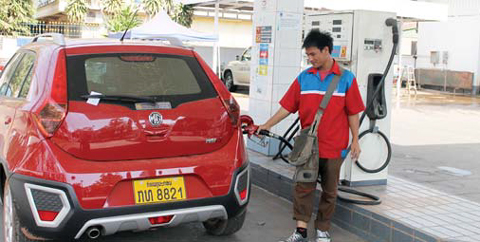Fuel Prices To Keep On Dropping
Petroleum operators expect fuel prices will continue to drop for the next few months after seeing prices go down since the beginning of the year.
The government has lowered the prices of premium, regular petrol and diesel in Vientiane and five provinces effective last Friday. “It is the third time for a fuel price reduction this year,” an official of a local fuel supplier, Petroleum Trading Lao Public Company (PTL), said on Saturday.
Meanwhile, a Lao Petroleum and Gas Association official expected that fuel prices may continue falling this month. The official of PTL also said that the prices may keep falling for the next few months.
The association official and its members reported similar information with the falling fuel prices due to current increased oil production by OPEC.
The Ministry of Industry and Commerce announced last Friday that the price of premium petrol had dropped by between 260 and 280 kip per litre, regular petrol was between 210 and 220 kip per litre lower and diesel had decreased between 230 and 240 kip per litre.
The new pricing is effective in Vientiane and the provinces of Khammuan, Savannakhet, Champassak, Bokeo and Xieng Khuang.
In Vientiane, petrol stations are now selling premium petrol for 9,820 kip per litre, regular petrol for 8,580 kip per litre and diesel for 7,560 kip per litre.
In the five provinces, the price of premium petrol is 9,840 to 9,940 kip per litre, regular petrol is 8,610 to 8,810 kip per litre and diesel is 7,580 to 7,790 kip per litre.
World fuel prices fluctuate in accordance with production and shifts in the global market and fuel prices in Laos reflect these movements.
The association reported recently that normally the fuel price often increases at this time of the year as there is a surge in consumption during the winter in America and European countries. These countries will use a large amount of fuel as energy for heat and to power appliances.
Consumption also rises in Asian countries because it is the dry season, when these countries use a large amount of fuel for infrastructure development and construction projects.
Laos imports fuel from Thailand and Vietnam, and about 25 to 30 percent of the total imported fuel is used in the rainy season. The rest of about 75 to 70 percent is used in the dry and hot seasons.
The association also reported that total fuel supply by its members in Laos was more than 911 million litres in 2013 and had since risen considerably. Last year the supply was about 1.178 billion litres and has since risen by about 7 to 10 percent.
PTL reported that by 2020 the annual demand for fuel will grow to about 2.8 billion litres nationwide, up from about 1.2 billion litres in 2013. The 2.8 billion will include the supply of about 560 million litres from PTL at a cost of approximately 4.8 trillion kip (US$600 million).
According to the OPEC monthly oil market report, posted on its website on January 15, global oil demand is estimated to have grown by 0.95 million barrels per day (mb/d) in 2014, representing an upward revision of 20 thousand barrels per day (tb/d) from the previous month. In 2015, world oil demand is anticipated to rise by 1.15 mb/d.
Non-OPEC oil supply is estimated to have grown by 1.98 mb/d in 2014, following an upward revision of 260 tb/d from the previous report, driven by higher than expected growth seen at the end of the year. In 2015, non-OPEC oil supply is projected to grow by 1.28 mb/d, representing a downward revision of 80 tb/d from the previous report.
OPEC natural gas liquids and non-conventional liquids are expected to average 6.03 mb/d in 2015, up from 5.83 mb/d in 2014. In December, OPEC crude oil production averaged 30.20 mb/d.
Source: Vientiane Times



